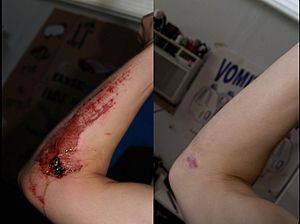Scar facts for kids
A scar is a natural part of how your body heals itself after an injury. When your skin gets hurt, like from a cut or burn, your body works to fix the damage. Instead of growing back the exact same skin, it often creates a different kind of tissue called scar tissue. This scar tissue helps close the wound and protect your body.
Scars can look different from the skin around them. They might be a different color, feel a bit bumpy or smooth, and sometimes they don't have hair or sweat glands like normal skin. They are a sign that your body has done an amazing job of repairing itself!
Contents
How Does Your Body Heal and Make Scars?
When you get a cut or scrape, your body starts a special healing process.
- Step 1: Stop the bleeding. Your blood forms a clot to stop the blood from flowing out.
- Step 2: Fight germs. White blood cells come to the area to clean out any dirt or germs.
- Step 3: Build new tissue. Special cells called fibroblasts start making new tissue, mostly a protein called collagen. Collagen is like the "glue" that holds your skin together.
- Step 4: Form the scar. As the new collagen forms, it creates a scar. This new tissue is strong but might not look exactly like your original skin.
Why Do Scars Look Different?
Scars look different because the new collagen fibers are laid down in a more organized way than the fibers in normal skin. Also, scar tissue often lacks some of the things normal skin has, like hair follicles (where hair grows) and sweat glands. This is why scars can feel smoother or look shinier.
Types of Scars You Might See
Not all scars are the same. Here are a few common types:
- Flat, pale scars: Most scars start out red and raised, but over time, they usually flatten out and become paler than the surrounding skin. These are the most common type.
- Raised scars (Hypertrophic scars): Sometimes, the body makes too much collagen, causing the scar to be raised above the skin. These scars usually stay within the area of the original wound.
- Keloid scars: These are similar to raised scars but grow much larger than the original wound. They can be lumpy and itchy. Some people are more likely to get keloid scars than others.
- Pitted or sunken scars (Atrophic scars): These scars look like small dips or holes in the skin. They happen when there isn't enough collagen made during the healing process. Acne scars or chickenpox scars are often this type.
- Stretch marks: These are a type of scar that happens when the skin stretches or shrinks quickly, like during a growth spurt or pregnancy. They often look like lines or streaks.
Caring for Scars
While scars are permanent, there are things you can do to help them heal well and look their best.
- Keep wounds clean: This helps prevent infection, which can make scars worse.
- Moisturize: Keeping the scar moist can help it heal more smoothly.
- Sun protection: New scars are very sensitive to the sun and can become darker if exposed. Using sunscreen or covering them up is a good idea.
- Massage: Gently massaging a new scar can sometimes help flatten it and make it softer.
Remember, scars are a natural part of life and show your body's amazing ability to heal!
Images for kids
See also
 In Spanish: Cicatriz para niños
In Spanish: Cicatriz para niños



